Hare
| Hares | |
|---|---|
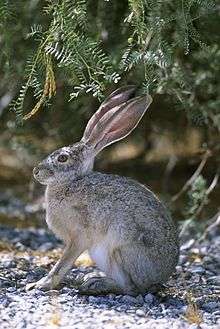 | |
| Scientific classification | |
| Kingdom: | Animalia |
| Phylum: | Chordata |
| Class: | Mammalia |
| Order: | Lagomorpha |
| Family: | Leporidae |
| Genus: | Lepus Linnaeus, 1758 |
| Type species | |
| Lepus timidus Linnaeus, 1758 | |
| Species | |
|
See text | |
Hares and jackrabbits are leporids belonging to the genus Lepus. Hares are classified into the same family as rabbits. They are similar in size and form to rabbits and eat the same diet. They are generally herbivorous and long-eared, they are fast runners, and they typically live solitarily or in pairs. Hare species are native to Africa, Eurasia, North America, and the Japanese archipelago.
Five leporid species with "hare" in their common names are not considered true hares: the hispid hare (Caprolagus hispidus), and four species known as red rock hares (comprising Pronolagus). Meanwhile, jackrabbits are hares rather than rabbits.
A hare less than one year old is called a leveret. The collective noun for a group of hares is a "drove".
Biology
Hares are swift animals: The European hare (Lepus europaeus) can run up to 56 km/h (35 mph).[1][2] The five species of jackrabbits found in central and western North America are able to run at 64 km/h (40 mph), and can leap up to 3 m (10 ft) at a time.[3]
Normally a shy animal, the European brown hare changes its behavior in spring, when hares can be seen in daytime chasing one another; this appears to be competition between males to attain dominance (and hence more access to breeding females). During this spring frenzy, hares can be seen "boxing", one hare striking another with its paws (probably the origin of the term "mad as a March hare"). For a long time, this had been thought to be intermale competition, but closer observation has revealed it is usually a female hitting a male to prevent copulation.[4]
Differences from rabbits
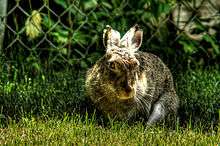
Hares do not bear their young below ground in a burrow as do other leporids, but rather in a shallow depression or flattened nest of grass called a form. Young hares are adapted to the lack of physical protection, relative to that afforded by a burrow, by being born fully furred and with eyes open. They are hence precocial, and are able to fend for themselves soon after birth. By contrast, the related rabbits and cottontail rabbits are altricial, having young that are born blind and hairless.[5]
All rabbits (except the cottontail rabbits) live underground in burrows or warrens, while hares (and cottontail rabbits) live in simple nests above the ground, and usually do not live in groups. Hares are generally larger than rabbits, with longer ears, and have black markings on their fur. Hares have not been domesticated, while rabbits are raised for food and kept as house pets. The domestic pet known as the "Belgian Hare" is a rabbit that has been selectively bred to resemble a hare.[6]
Hares have jointed, or kinetic, skulls, unique among mammals. They have 48 chromosomes while rabbits have 44.
Classification
The 32 species listed are:
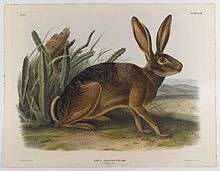
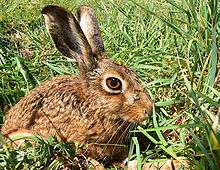

- Genus Lepus[7]
- Subgenus Macrotolagus
- Antelope jackrabbit, Lepus alleni
- Subgenus Poecilolagus
- Snowshoe hare, Lepus americanus
- Subgenus Lepus
- Arctic hare, Lepus arcticus
- Alaskan hare, Lepus othus
- Mountain hare, Lepus timidus
- Subgenus Proeulagus
- Black-tailed jackrabbit, Lepus californicus
- White-sided jackrabbit, Lepus callotis
- Cape hare, Lepus capensis
- Tehuantepec jackrabbit, Lepus flavigularis
- Black jackrabbit, Lepus insularis
- Scrub hare, Lepus saxatilis
- Desert hare, Lepus tibetanus
- Tolai hare, Lepus tolai
- Subgenus Eulagos
- Broom hare, Lepus castroviejoi
- Yunnan hare, Lepus comus
- Korean hare, Lepus coreanus
- Corsican hare, Lepus corsicanus
- European hare, Lepus europaeus
- Granada hare, Lepus granatensis
- Manchurian hare, Lepus mandschuricus
- Woolly hare, Lepus oiostolus
- Ethiopian highland hare, Lepus starcki
- White-tailed jackrabbit, Lepus townsendii
- Subgenus Sabanalagus
- Ethiopian hare, Lepus fagani
- African savanna hare, Lepus microtis
- Subgenus Indolagus
- Hainan hare, Lepus hainanus
- Indian hare, Lepus nigricollis
- Burmese hare, Lepus peguensis
- Subgenus Sinolagus
- Chinese hare, Lepus sinensis
- Subgenus Tarimolagus
- Yarkand hare, Lepus yarkandensis
- Incertae sedis
- Japanese hare, Lepus brachyurus
- Abyssinian hare, Lepus habessinicus
- Subgenus Macrotolagus
As food
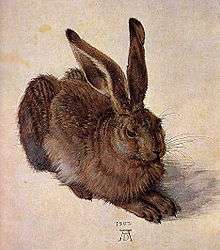
Hares and rabbits are plentiful in many areas, adapt to a wide variety of conditions, and reproduce quickly, so hunting is often less regulated than for other varieties of game. In rural areas of North America and particularly in pioneer times,[8] they were a common source of meat. Because of their extremely low fat content, they are a poor choice as a survival food.[9]
Hares can be prepared in the same manner as rabbits — commonly roasted or taken apart for breading and frying.
Hasenpfeffer (also spelled Hasenfeffer) is a traditional German stew made from marinated rabbit or hare. Pfeffer is not only the name of a spice, but also of a dish where the animal's blood is used as a thickening agent for the sauce. Wine or vinegar is also a prominent ingredient, to lend a sourness to the recipe.
Lagos Stifado (Λαγός στιφάδο) — hare stew with pearl onions, vinegar, red wine and cinnamon — is a much-prized dish enjoyed in Greece and Cyprus and communities in the diaspora, particularly in Australia where the hare is hunted as a feral pest.
Jugged hare, known as civet de lièvre in France, is a whole hare, cut into pieces, marinated, and cooked with red wine and juniper berries in a tall jug that stands in a pan of water. It traditionally is served with the hare's blood (or the blood is added right at the very end of the cooking process) and port wine.[10][11][12][13]
Jugged hare is described in the influential 18th-century cookbook, The Art of Cookery by Hannah Glasse, with a recipe titled, "A Jugged Hare", that begins, "Cut it into little pieces, lard them here and there ..." The recipe goes on to describe cooking the pieces of hare in water in a jug set within a bath of boiling water to cook for three hours.[14] Beginning in the 19th century, Glasse has been widely credited with having started the recipe with the words "First, catch your hare," as in this citation.[11] This attribution is apocryphal.
Having a freshly caught (or shot) hare enables one to obtain its blood. A freshly killed hare is prepared for jugging by removing its entrails and then hanging it in a larder by its hind legs, which causes the blood to accumulate in the chest cavity. One method of preserving the blood after draining it from the hare (since the hare is usually hung for a week or more) is to mix it with red wine vinegar to prevent coagulation, and then to store it in a freezer.[15][16]
Many other British cookbooks from before the middle of the 20th century have recipes for jugged hare. Merle and Reitch[17] have this to say about jugged hare, for example:
- The best part of the hare, when roasted, is the loin and the thick part of the hind leg; the other parts are only fit for stewing, hashing, or jugging. It is usual to roast a hare first, and to stew or jug the portion which is not eaten the first day. [...]
- To Jug A Hare. This mode of cooking a hare is very desirable when there is any doubt as to its age, as an old hare, which would be otherwise uneatable, may be made into an agreeable dish. [...]
In 2006, a survey of 2021 people for the UKTV Food television channel found only 1.6% of the people under 25 recognized jugged hare by name. Seven of 10 stated they would refuse to eat jugged hare if it were served at the house of a friend or a relative.[18][19]
The hare (and in recent times, the rabbit) is a staple of Maltese cuisine. The dish was presented to the island's Grandmasters of the Sovereign Military Order of Malta, as well as Renaissance Inquisitors resident on the island, several of whom went on to become pope.
According to Jewish tradition, the hare is among mammals deemed not kosher, and therefore not eaten by observant Jews. According to Islamic dietary laws, Muslims deem coney meat (rabbit, pika, hyrax) halal, and in Egypt, hare and rabbit are popular meats for mulukhiyah (jute leaf soup), especially in Cairo.[20] The Shia, though, have difference in opinion.
In England, a now rarely served dish is potted hare. The hare meat is cooked, then covered in at least one inch (preferably more) of butter. The butter is a preservative (excludes air); the dish can be stored for up to several months. It is served cold, often on bread or as an appetizer.
Folklore and mythology
The hare in African folk tales is a trickster; some of the stories about the hare were retold among African slaves in America, and are the basis of the Br'er Rabbit stories. The hare appears in English folklore in the saying "as mad as a March hare" and in the legend of the White Hare that alternatively tells of a witch who takes the form of a white hare and goes out looking for prey at night or of the spirit of a broken-hearted maiden who cannot rest and who haunts her unfaithful lover.[21][22]
Many cultures, including the Chinese, Japanese, and Mexican, see a hare in the pattern of dark patches in the moon (see Moon rabbit. The constellation Lepus is also taken to represent a hare.
The hare was once regarded as an animal sacred to Aphrodite and Eros because of its high libido. Live hares were often presented as a gift of love.[23] Now the hare is commonly associated with the Anglo-Saxon goddess Ēostre, and therefore pagan symbols like the Easter Bunny have been appropriated into the Christian tradition. However, no primary sources support this belief, which seems to be a modern invention.[24]
In European tradition, the hare symbolises the two qualities of swiftness[25] and timidity.[26] The latter once gave the European hare the Linnaean name Lepus timidus[27] that is now limited to the Mountain hare. Several ancient fables depict the Hare in flight; in one concerning The Hares and the Frogs they even decide to commit mass suicide until they come across a creature so timid that it is even frightened of them. Conversely, in The Tortoise and the Hare, the best-known among Aesop's Fables, the hare loses a race through being too confident in its swiftness. In Irish folklore, the hare is often associated with Sidh (Fairy) or other pagan elements. In these stories, characters who harm hares often suffer dreadful consequences.
In June 2014, the Pushkin House (the Institute of Russian Literature of the Russian Academy of Sciences) hosted the international conference, "The Philosophy of the Hare: Unexpected perspectives in the research in the humanities".[28] The conference organizers came up with the idea as a retort to an earlier claim by Russia's Minister of Culture Vladimir Medinsky that humanities scholars were wasting government money conducting research on incomprehensible topics with names such as the one they chose.
Famous hares in fiction
Famous hares in art
Three hares

A study in 2004 followed the history and migration of a symbolic image of three hares with conjoined ears. In this image, three hares are seen chasing each other in a circle with their heads near its centre. While each of the animals appears to have two ears, only three ears are depicted. The ears form a triangle at the centre of the circle and each is shared by two of the hares. The image has been traced from Christian churches in the English county of Devon right back along the Silk Road to China, via western and eastern Europe and the Middle East. Before its appearance in China, it was possibly first depicted in the Middle East before being reimported centuries later. Its use is associated with Christian, Jewish, Islamic and Buddhist sites stretching back to about 600 CE.[29]
Place names
The hare has given rise to local place names, as they can often be observed in favoured localities. An example in Scotland is 'Murchland', 'murchen' being a Scots word for a hare.[30]
See also
References
- ↑ McKay, George; McGhee, Karen (10 October 2006). National Geographic Encyclopedia of Animals. National Geographic Books. p. 68. ISBN 9780792259367.
- ↑ Vu, Alan. "Lepus europaeus: European hare". Animal Diversity Web. University of Michigan Museum of Zoology. Retrieved 9 January 2013.
- ↑ "Jackrabbits, Jackrabbit Pictures, Jackrabbit Facts - National Geographic". Animals.nationalgeographic.com. Retrieved 2013-01-12.
- ↑ The myth of the mad March hare, Nature 309, 549 - 550. Holly, Anthony J. F. et al. Retrieved July 03 2010.
- ↑ Langley, Liz (19 December 2014). "What's the Difference Between Rabbits and Hares?". National Geographic.
- ↑ Pet Planet - Small Breed Profile - Belgian Hare
- ↑ Hoffman, R.S.; Smith, A.T. (2005). "Order Lagomorpha". In Wilson, D.E.; Reeder, D.M. Mammal Species of the World: A Taxonomic and Geographic Reference (3rd ed.). Johns Hopkins University Press. pp. 195–205. ISBN 978-0-8018-8221-0. OCLC 62265494.
- ↑ Brock (2009-05-18). "Mormon Pioneer Foodways: Rabbit, anyone?". Pioneerfoodie.blogspot.com. Retrieved 2010-03-20.
- ↑ Gary L. Benton. "Survival Nutrition". Simple Survival. Retrieved 2010-03-20.
- ↑ Tom Jaine. "A Glossery of Cookery and other Terms". The History of English Cookery. Prospect Books.
- 1 2 "Chips are down for Britain's old culinary classics". The Guardian. 2006-07-25. p. 6.
- ↑ "Jugged". The Great British Kitchen. The British Food Trust.
- ↑ "Recipes: Game: Jugged Hare". The Great British Kitchen. The British Food Trust.
- ↑ Glasse, Hannah. The Art of Cookery, Made Plain and Easy. London, 1747. page 50
- ↑ Bill Deans. "Hares, Brown, Blue or White.".
- ↑ John and Sally Seymour (September–October 1976). "Farming for Self-Sufficiency Independence on a 5-acre (20,000 m2) Farm". Mother Earth News (41).
- ↑ Gibbons Merle and John Reitch (1842). The domestic dictionary and housekeeper's manual. London: William Strange. p. 113.
- ↑ "Bygone food quiz reveals pig ignorance among young". The Scotsman. 2006-07-24.
- ↑ Martin Hickman (2006-07-24). "Young diners lose taste for traditional British dishes". The Independent. Archived from the original on February 18, 2007.
- ↑ http://www.taste.com.au/kitchen/recipes/rabbit+molokhia,8279. Missing or empty
|title=(help) - ↑ "The White Hare". Folk-this.tripod.com. 1969-05-13. Retrieved 2013-01-12.
- ↑ "Legends of Britain: The White Hare". Britannia.com. Retrieved 2013-01-12.
- ↑ John Layard, The Lady of the Hare, "The Hare in Classical Antiquity", pp.208 - 21
- ↑ Hunt-Anschütz, A. Æ. (2006). "Eostre and Easter Customs". Association of Polytheist Traditions.
- ↑ As fast as a hare
- ↑ Ebenezer Cobham Brewer, Dictionary of Phrase and Fable, Cambridge University 2014, p.32
- ↑ The Popular Encyclopaedia 3.2., Glasgow 1836, p.634
- ↑ "Философия зайца": неожиданные перспективы гуманитарных исследований" ("The Philosophy of the Hare: Unexpected perspectives in the research in the humanities")
- ↑ Chris Chapman (2004). "The three hares project". Retrieved 2008-11-11.
- ↑ Warrack, Alexander, ed. (1984). Chambers Scots dictionary. Edinburgh: W. & R. Chambers. ISBN 9780550118011.
Further reading
- Windling, Terri. The Symbolism of Rabbits and Hares.
- William George Black, F.S.A.Scot. "The Hare in Folk-lore" The Folk-Lore Journal. Volume 1, 1883.
External links
| Wikimedia Commons has media related to Lepus. |
| Look up hare in Wiktionary, the free dictionary. |